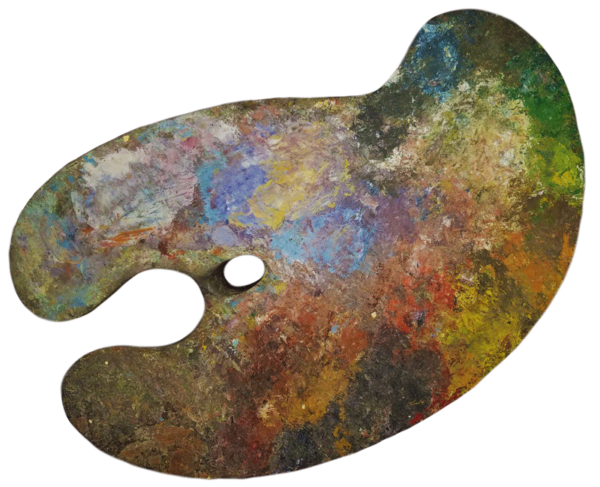
The House of the Singing Winds
4220 T.C. Steele Road
Nashville, Indiana 47448 USA
Latitude: 39.13090°N, Longitude: 86.34851°W
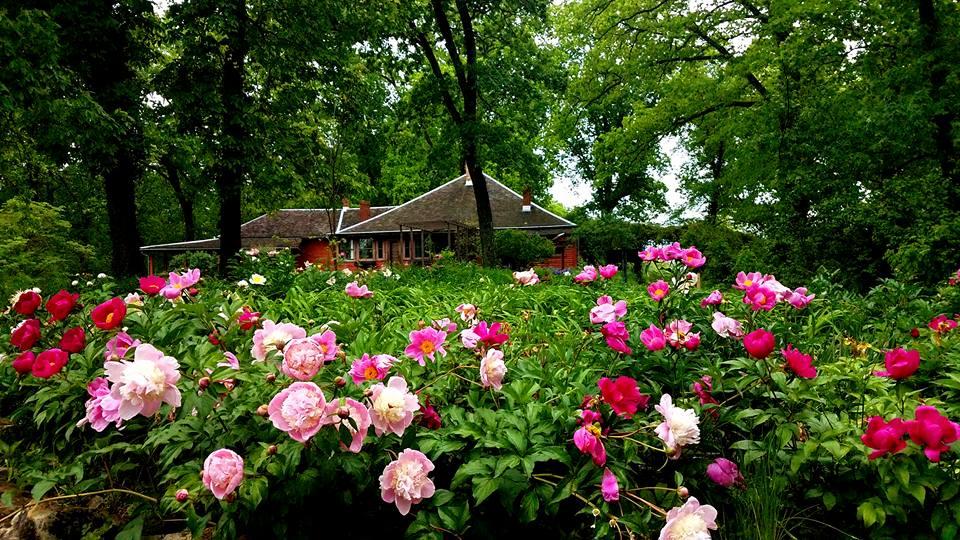
Paradise in Brown County
Welcome to the lovingly designed home of T.C. Steele and his wife Selma. The couple moved to Brown County, Indiana in 1907 and established a home, studio and gardens on 211 acres of scenic terrain. The property and its artifacts remain essentially unchanged from the way it was during their time here.
This beautiful historic site is one of a few preserved artist residences with studios and gardens. When T.C. Steele died in 1926, his wife Selma continued living in the home until her own death in 1945. Mrs. Steele transferred all of the property, including furnishing and artwork to the state of Indiana and where it remains today under the management of the Indiana State Museum and Historic Sites. The house and studio are arranged and furnished with virtually all of the origin artifacts. When you experience this visit, you will see the home, studio and gardens as they were when the Steele’s lived there.
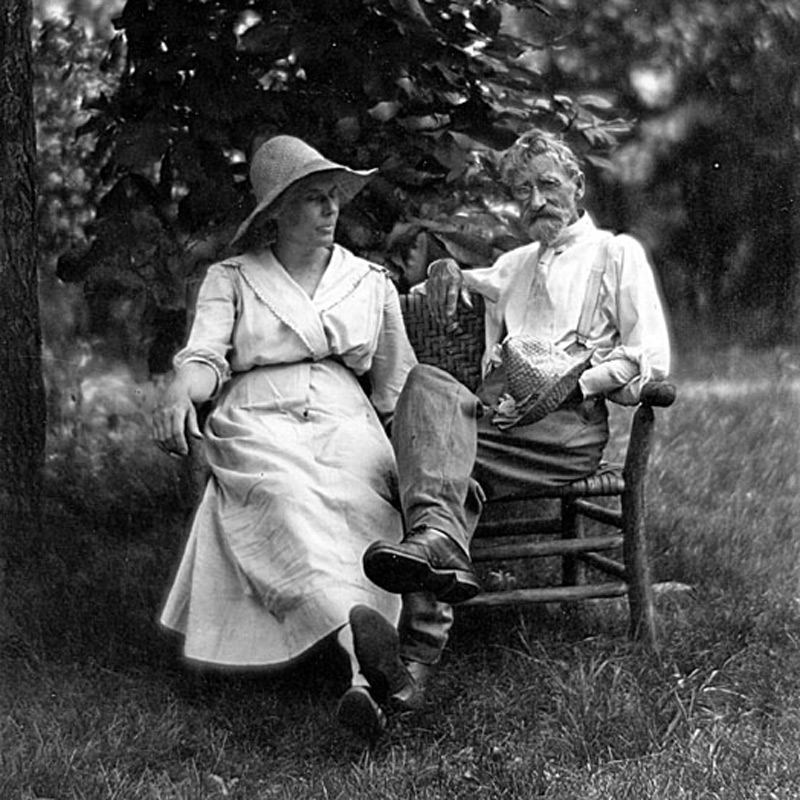
The property is listed on the National Register of Historic Places, National Trust for Historic Preservation, Historic Home & Artists Studios, American Alliance of Museums, Historic Iris Preservation Society, and is the recipient of an Indiana Historical Bureau Marker.
In addition to the home, studio and outbuildings, the site includes Selma Steele’s formal gardens. Designated as an official “Historic Iris Preservation Display Garden” by the Historic Iris Preservation Society, it is one of only three public gardens in the State of Indiana to hold such status. Be sure to visit the gardens while on the property.


Making a House a Home
Entire books have been written about the Steeles’ time in Brown County, living in the House of the Singing Winds. T.C. Steele painted the home many times, and Selma Steele wrote extensively about their efforts to make the house a home; it was clearly a favorite subject for both.
“My dear, if you think you can manage to live in this wilderness, we will build our home here – on a hill.”
T.C. Steele 5
The Crooked House
When you visit this historic site, look at the house, it’s easy to see the west wing is angled away from the rest of the house. The house looks like it’s bent in the middle. When he first moved to Brown County, Mr. Steele planned to combine living space with studio space. That didn’t work well because of the mess and smell of paint and turpentine, so the second year the Steeles added the west wing as a separate studio space.
Why is there an angle? When the first part of the house was built, Mr. Steele probably used a compass to figure out the direction his studio window should face. He didn’t take into account that magnetic north—the alignment of the magnetic north pole that a compass detects—is several degrees off of “true north” according to the tilt of the earth and the angle of the sun. When the west wing was built, Mr. Steele corrected his mistake, so his new studio windows faced true north.6
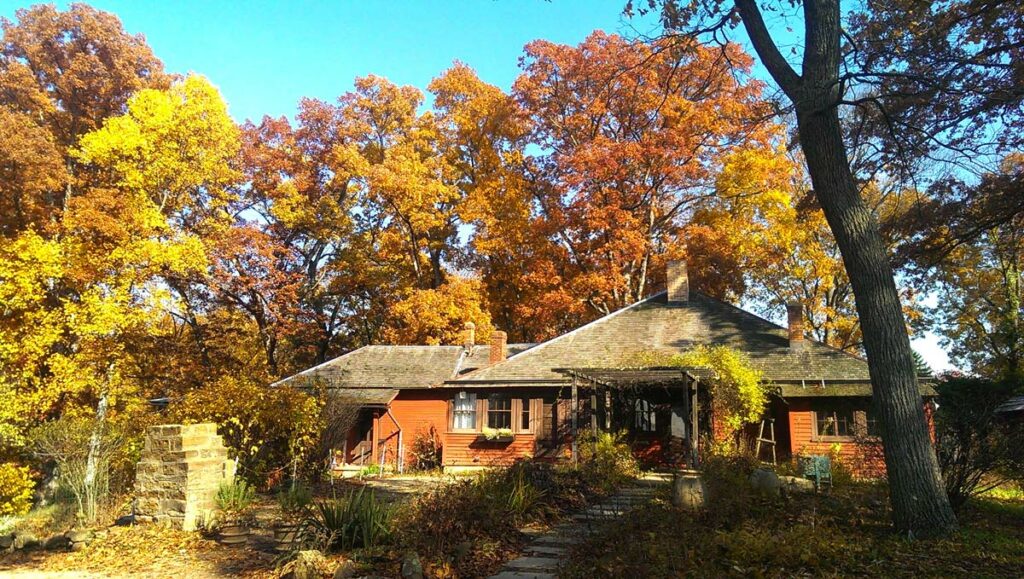
Room to Grow
As the House of the Singing Winds transitioned from a seasonal retreat to a year-round home, it underwent many expansions and changes. Rooms were added, porches were enclosed, and cosmetic features came and went. Fortunately, these changes are well documented by historic photographs, paintings, and by physical evidence.
“Houses may be bought, but homes grow out of the heart’s depths.”
T.C. Steele 7
The last major change made by the Steele’s was to enclose a large, L-shaped south and east-facing porch for year-round use. Apparently, however, the Steele’s were unwilling to entirely give up the last of their nice porches and came up with an interesting solution: instead of installing standard double-sash windows, the wall and framing beneath the windows were built with hinged window sills. When the sills are flipped over and both window sashes are unlatched, the entire window slides down into the wall. Voila! In the space of about ten minutes, the entire room could be converted back into a porch for those hot summer days. Although most of the windows are no longer fully operable, two have been restored to full functionality.
We’re not sure where Steele’s got the inspiration for this unusual feature. It’s an extremely rare feature in a house, but it’s more often found in vintage houseboats. Both T.C. and Selma Steele did a lot of travelling in their lives… perhaps one of them saw it and remembered it years later?


L. The unusual convertible porch; R: Friend and colleague Gustave Baumann engraved the inscription “Every morning I take off my hat to the beauty of the world” over the fireplace.
Luxury in the Wild
You could call the house innovative, especially for the time. The Steeles installed a Delco Generator System. The generator is a 1918 model. At first, the Steele’s built the House of the Singing Winds as a rustic, seasonal retreat, but as it gradually became a full-time home the house was expanded, and modern conveniences were added. However, rural electrification was still decades away.
To operate the generator, the engine would be primed with gasoline. Once it was started using a hand crank—which took a bit of muscle—the generator ran on kerosene to charge a bank of sixteen batteries hooked up in series. Depending on how much electricity was used, it would take several days to a week for the batteries to run down. Then, the process would repeat.6
Delco systems like the one installed by the Steeles were expensive—only the most prosperous residents in Brown County would have been able to afford one—but they were no longer as rare as they would have been just a few years earlier. Prosperous farm dwellers could easily mail order them from catalogs.
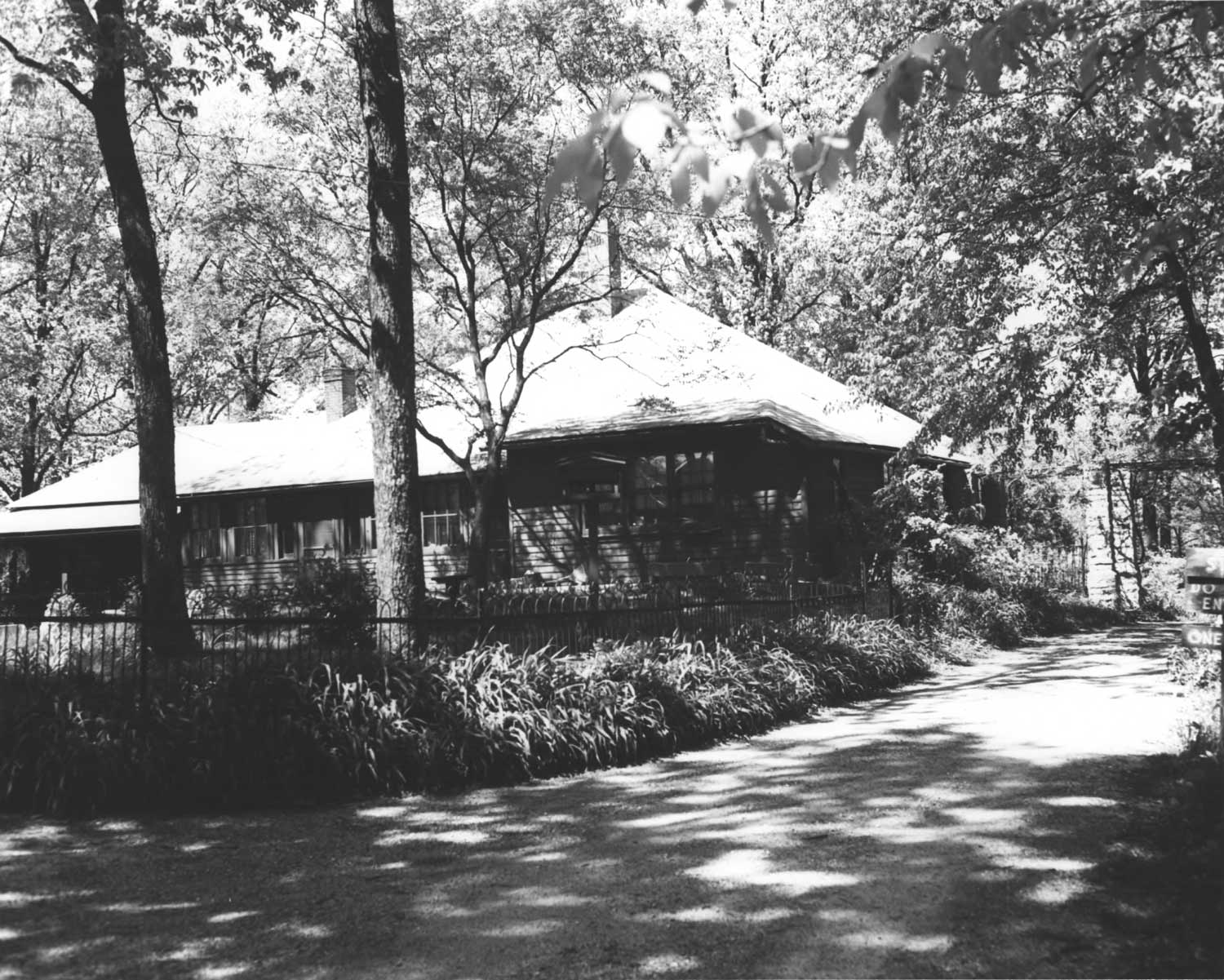
What makes the system in the House of the Singing Winds rare is that they almost never remain intact. In addition to the generator itself, all but two of the sixteen batteries have survived, as has the fuse box and some of the knob-and-tube wiring and insulators. Historic photographs show an electrical line extended from the house to the large studio, indicating that the generator provided electricity for lighting in both buildings. Remnants of the knob-and-tube insulators can also be seen in the basement stairwell of the large studio.
Serial numbers on some parts indicate the system underwent an overhaul, or at least fairly major repairs, sometime in the 1930s. The House of the Singing Winds was ultimately hooked up to the power grid in 1948, but former caretaker Fabius Gwinn recounted in an oral history interview that the generator was still used for emergency power as late as the 1960s.
An interesting tidbit…the Steele’s didn’t like to waste anything. If you walk down the cellar steps and shine a flashlight over your head, you can see that they re-used the lumber from the crates in which the batteries were shipped to enclose the stairwell. The stenciling from the shipping crates is clearly visible.6



The Large Studio had soaring, north-facing windows.9; Door to the Studio, with sign “Seasons come and go. Eternal change – but always with their gifts of beauty. T.C. Steele”10; Studio interior 11.
It’s All About the Light
“Light and geography” shaped the architecture of the House of the Singing winds, and the large studio. The most desirable light for an artist in the northern hemisphere of the earth is light that comes from the north. That’s because as the earth tilts through the seasons and rotates from morning to night, the light of the sun is always angled slightly from the south.
So, a window that faces the north never gets direct sunlight; instead, it gets constant, soft, indirect light that doesn’t change much from morning till evening as the sun moves across the sky. That’s why Mr. Steele built all his studios with big north windows.
A Day at the House
T.C. Steele would paint early, and if on the property, he and Selma might have lunch and he would paint again in the afternoon. They often sat in the parlor of the house at a table by the fireplace and were both well read. They entertained often and the house and property required much physical work to maintain, including the gardens. Visitors often ask if Mrs. Steele had outside help. The answer is yes, but is a bit more complicated, though…



T.C. Steele outside the House of the Singing Winds12; Selma’s dog, Prince13; Selma and T.C. Steele in the parlor of the House of the Singing Winds14
“Outside help” was usually easy to find—there were usually young men willing to make a bit of money, and as Mr. Steele was both older and a “city feller,” it was expected that he would need help for heavy outdoor work. The problem was that it was Selma Steele who was the gardener. They did not take well to taking orders from a woman. That she was a city woman made it even worse! In order to get anything done at all, Mrs. Steele concocted a system of relaying orders through her husband. Even then, she recounted that she was often driven nearly to tears.
Hiring local girls to help with household chores was even more complicated. The local women were uncertain of her motives. Firstly, she was from the city, which was automatically suspicious. Who knows what she might teach their innocent young daughters? Secondly, Mrs. Steele was neither pregnant, nor ailing, nor “puny,” so why would she seek to hire someone else to do what the locals felt she was perfectly capable of doing herself?
Eventually, Mrs. Steele was able to overcome some of the mistrust. Since early marriage was common, though, the only single girls were often quite young. Some of the earliest hired girls were only 10 to 12 years old. Mrs. Steele later recounted that as word spread, young local woman began to see her as an opportunity to leave farm life behind. She lamented that no sooner would she have a girl trained to meet her city-bred expectations, the girl would take her hard-earned experience to town for better pay and social opportunities.6


The fully restored kitchen; The Steele’s dining room
Because of their youth, many of the “girls” who worked for Mrs. Steele were still around to be interviewed in the 1980s and 1990s. One woman, in her 80s when she was interviewed, told of being hired at age 10. She would come to work on Mondays and remain at the Steeles until Saturday. As soon as she arrived on a Monday, she would begin carrying and heating water for laundry. Subsequent days were more leisurely.
First thing, in the mornings, she would help Mrs. Steele prepare breakfast. After breakfast, she would often walk with Mrs. Steele, and Mrs. Steele would teach her about the birds or whatever else caught their attention. A couple of hours would be spent working in the garden, and then it would be time to prepare lunch for Mr. Steele and carry it to where he was painting. Mr. Steele would usually return to the house in the early afternoon. He and Mrs. Steele would read, listen to music, and Mrs. Steele would often set lessons for her. She showed off a medal she had won in a spelling bee as a result of Mrs. Steele coaching her with her reading. Later afternoons would be spent doing household chores while Mr. Steele would go back outdoors to paint the evening light.6


The parlor of the House of the Singing Winds; An antique stuffed peacock rests by the window
Who Played the Piano?
When you visit the house, you will notice the piano in the parlor. Selma Steele played the piano, and T.C. Steele played the flute. They also had a piano in the large studio which is believed to be used by the Steeles primarily when entertaining – the acoustics in the large studio are amazing. There are flyers in the Steele historic site collection for Indiana University students’ piano recitals that took place in the large studio in the 1920’s. These student recitals continued after Steele’s death, into the 1930’s. Also retained In the Steele historic site collection, are many boxes of sheet music and 78 records. The sheet music and records are mostly classical and opera, piano and voice, some piano and flute. T.C. Steele painted two of his children, Margaret ( Daisy) and Shirley (Ted) at the piano in 1894. Selma’s sister Edith Neubacher came to live at the house prior to T.C. Steele’s death in 1926, after much of her family died in an influenza epidemic. Edith played the violin. Music was always part of living in the House of the Singing Winds.6
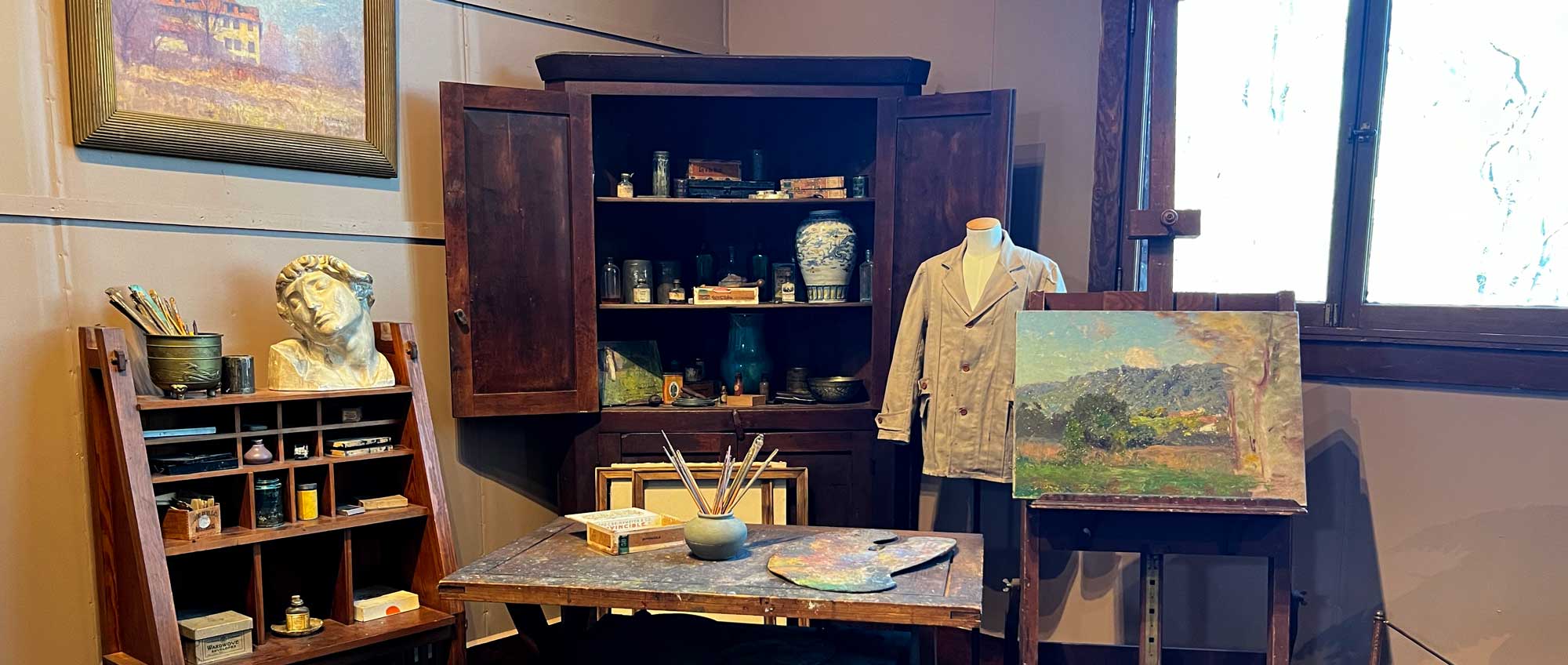
Brown County Art Colony
The picturesque landscape of this area, and Steele’s prominence drew in other artists, establishing an Art Colony of the Midwest.
The Brown Art Colony formed in the early 1900’s. Artists were attracted to the undisturbed, scenic landscape of this peaceful valley. Artist Adolph Schult is considered to be the founder of the art colony. T.C. Steele became the first artist in residence, and both Shulz and Steele influenced many other artists to come to the area. Gustave Baumann was among the first of this new group of artists coming to the area to make Brown County their home and establish studios there. The Brown County Art Gallery was founded in 1926 and continues to be an important institution to the town of Nashville, Indiana and the surrounding area.
Also important to the Brown County Art Colony is the Brown County Art Guild, founded by several of the colony’s original artists in 1954. The guild remains today and is also an important institution to the town of Nashville, Indiana and the surrounding area.
Related Steele Works

House of the Singing Winds
1916, Oil on canvas
By Permission, Haan Museum of Indiana Art, Lafayette, Indiana
The view is looking north-northeast from roughly the vantage point of where the top of the Large Studio walkway is today. Of note, the painting is signed and dated 1916, the same year the Large Studio was built.
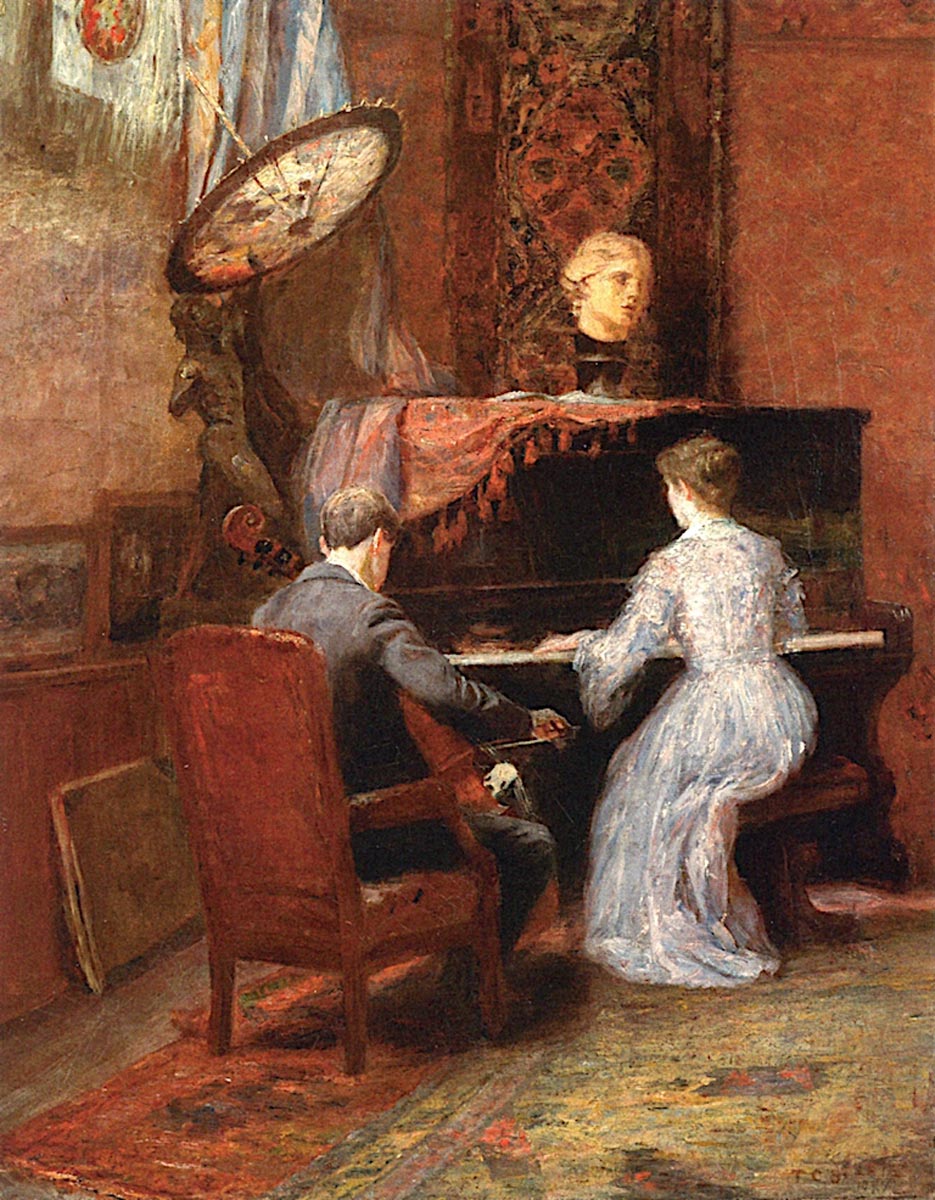
Interior Scene with Daisy and Shirley
1894, Oil on canvas
By Permission, Collection of the Haan Museum of Indiana Art, Lafayette, Indiana
This painting shows two of the Steele children, Margaret “Daisy” and Shirley “Ted”” sitting at the family piano, which remains today in the House of the Singing Winds. Notice the rumpled rug, paintings, umbrella and tapestries in the background, and a bust atop the piano.
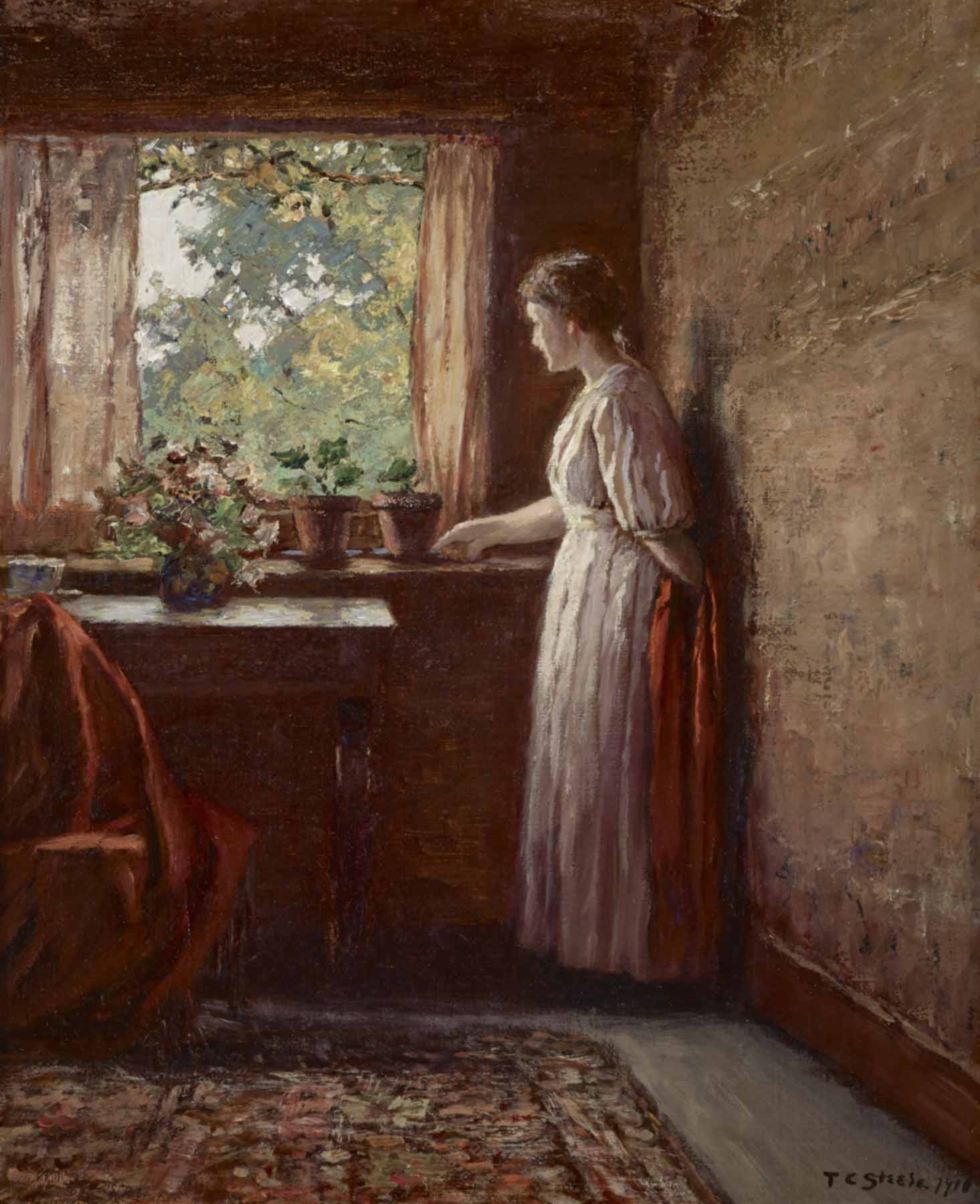
The Girl by the Window
1910, Oil on canvas
By permission Indiana Museum of Art/Newfields
This painting provides a unique view of the early interior of the House of the Singing Winds prior to restoration by the Steele’s completed in 1910. Historic site experts believe the subject is most likely Selma, but there is not documentation to support this.
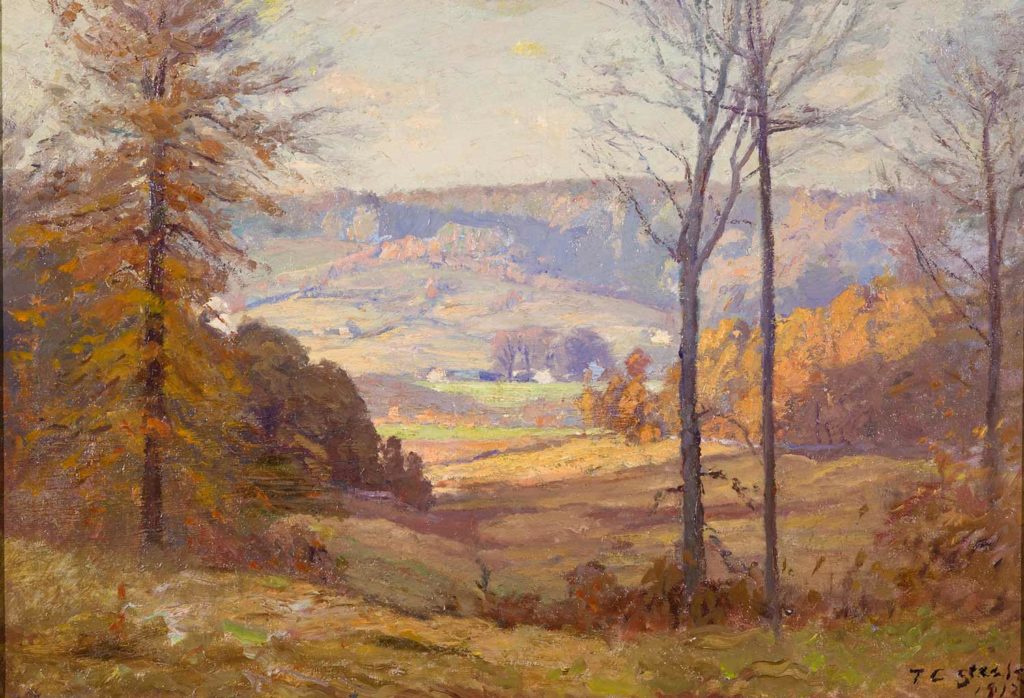
Valley Scene, Brown County
1912, Oil on canvas
By Permission, Richmond Art Museum, Richmond, Indiana
This painting captures the rolling hills, ridges, and valleys of Brown County in southern Indiana. Steele beautifully captured the contrasts between the brilliant sunshine on the distant hills, highlighting those hills, against the shadows in the foreground. This type of view and composition was likely an influence and inspiration for the later artists whom Steele pioneered to come down to Brown County for landscape painting, which began the establishment of the Brown County Art Colony.
Nearby Attractions
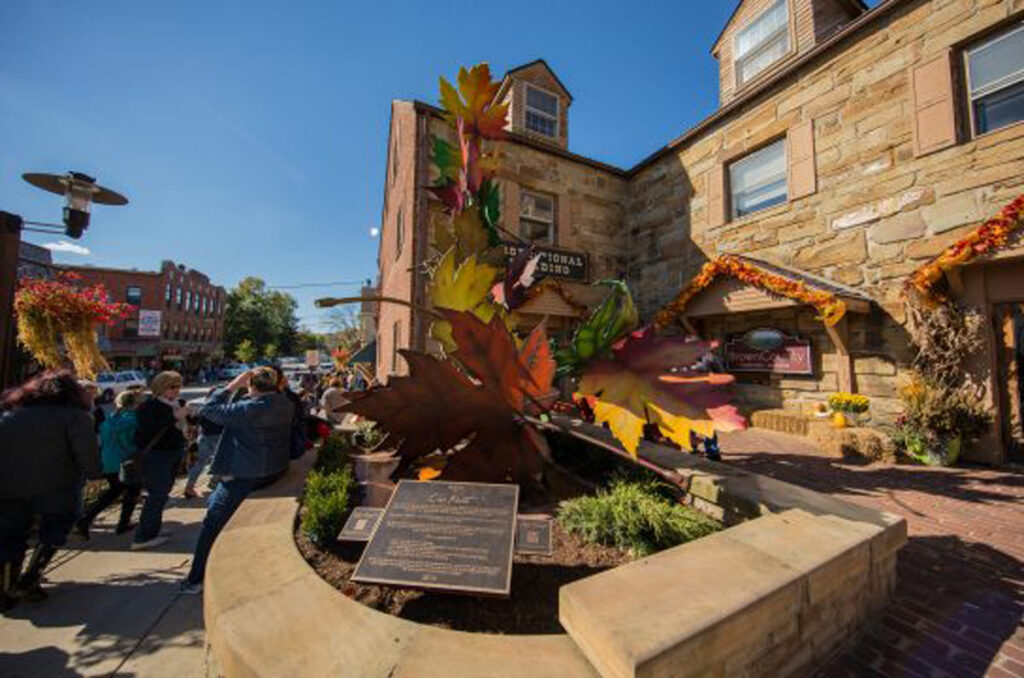
Town of Nashville, Indiana
Main and Van Buren Street
Nashville, Indiana located in Brown County, is a town of just over 800 people. Established in 1836, Nashville is widely known for being an art colony, and is home to the historic Brown County Art Guild, (1954) and Brown County Art Gallery (1926). T.C. Steele was the first artist to reside in the area (1907). He was followed by Adolph Shulz who began painting in the area in 1908 and moved to Nashville in 1917. Shulz is considered the “founder of the art colony” in Nashville, and lived here with his wife Ada Walter Shulz, also a painter. Nationally recognized printmaker and painter Gustave Baumann lived and worked as an artist in Nashville for six years (1910-1916), where he produced his first important set of color woodcuts. Today, Nashville continues to be a favorite destination for art, music and exploring the beautiful landscape of Brown County, which inspired the early artists of the Brown County art colony. You can travel on foot in the quaint, one-square-mile village.
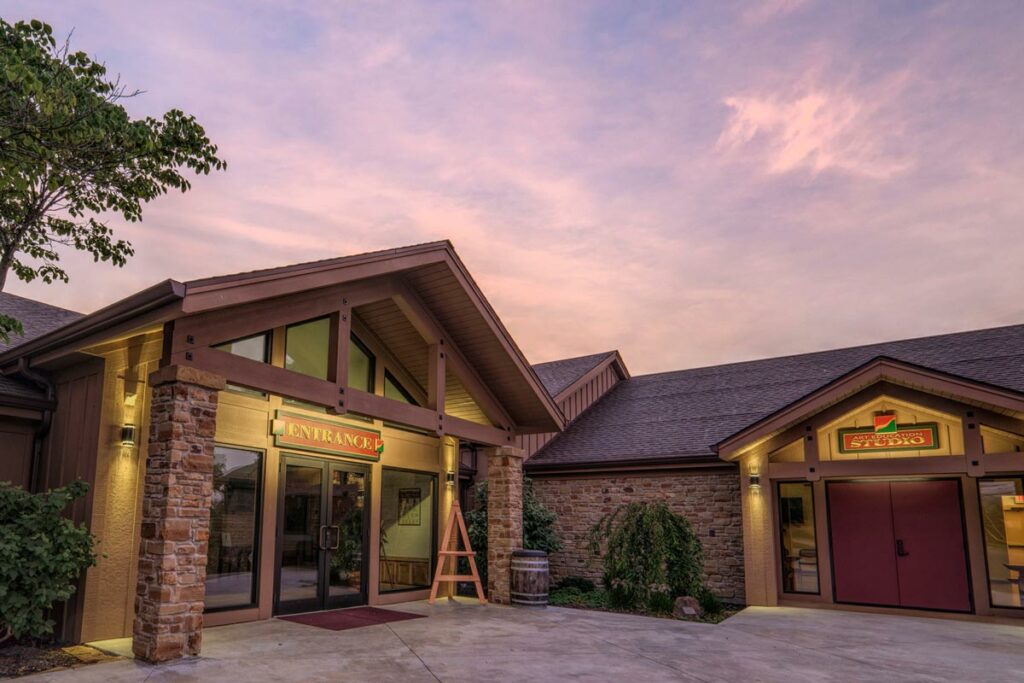
Brown County Art Gallery
1 Artist Dr
Nashville, IN 47448
The Brown County Art Gallery was founded in 1826, by the early colony of artists who came to paint the beautiful landscape of this area. Today, the gallery is home to several permanent collections including woodcuts by Gustave Bauman. The gallery has an impressive collection, and hosts events, shows, and consignment art, including work by contemporary artists Nancy Noel and John Mellencamp.
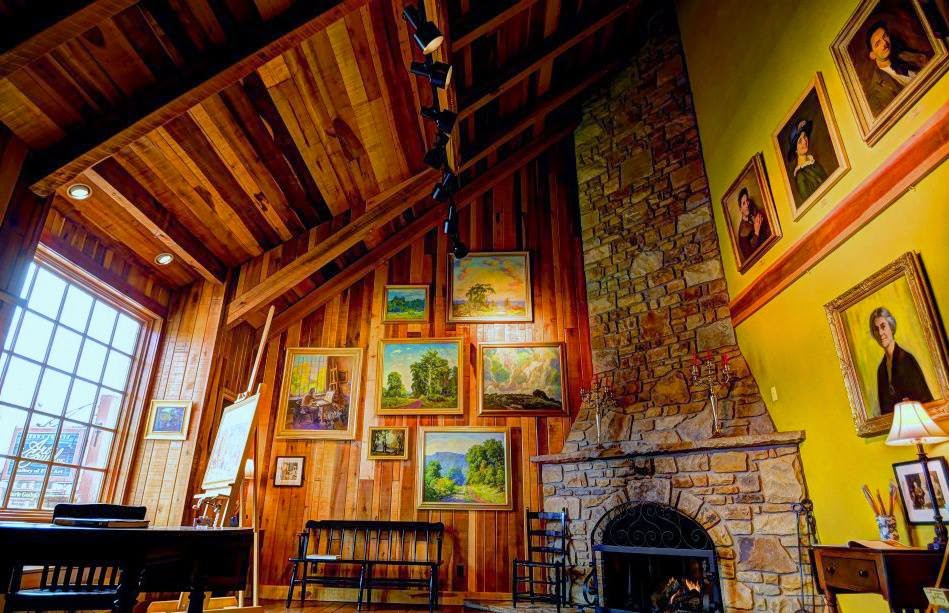
Brown County Art Guild
48 South Van Buren Street
Nashville, Indiana
The Brown County Art Guild is a living gallery that has both a permanent collection and rotating exhibits. The permanent collection includes work by Carl Christopher Graf, trained in art in New York and began painting in Brown County at the invitation of T.C. Steele. Many special events, workshops, and music are presented regularly at the Guild. More than 45 regional artists form the Brown County Art Guild, with each becoming a Guild artist by a stringent and juried process.
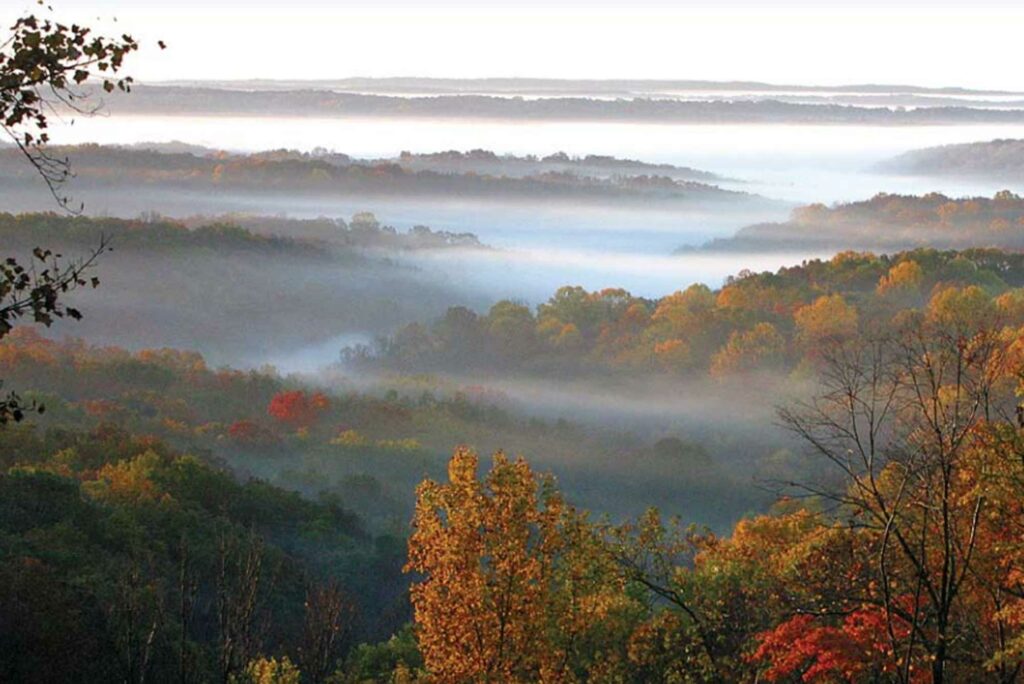
Brown County State Park
This beautiful park opened in 1929 and is the largest state park in Indiana with over 15,000 acres. Known for its scenic views, the park and surrounding areas are a destination spot for viewing autumn foliage as the changing leaf colors present a dramatic panorama. Sometimes, called “the Little Smokies” due to many similarities with the Great Smoky Mountains of North Caroline and Tennessee. The park has wonderful amenities including the Abe Martin Lodge, 32 hiking trails, and 70 miles of horse trails.
Suggested Itinerary
- Stamp your digital passport at the House of the Singing Winds.
- Hike any of the 5 trails on the 211-acre T.C. Steele State Historic Site, ranging from ¼ mile easy, to ½ mile difficult
- Hike Trail 3, Selma Steele’s own “Whippoorwill Trail” though the 92-acre Selma N. Steele Nature Preserve
- Visit T.C. Steele and Selma Steele gravesites at the bottom of the hillside near the House of the Singing Winds
- Visit the restored historic gardens on the grounds, established by Selma Steele
- Participate in one of the great selections of individual, family, and child activities at the historic site (check calendar & times first)
- Hike in nearby Yellowwood State Forest
- Visit the quaint village of Nashville (Brown County) Indiana
- In Nashville, find the Indiana Historical Bureau Marker celebrating The Brown County Art Colony
- Visit Brown County Art Gallery (Nashville), est. 1926
- Visit Brown County Art Guild (Nashville), est. 1954
- Visit Brown County State Park, est. 1929 and located on nearly 16,000 acres, the largest State Park in Indiana. Consider the rustic Abe Martin Lodge inside Brown County State Park for dining and overnight accommodations.
- Consider the nearby Historic Story Inn for dining and overnight accommodation – the Story Inn is set on 18 acres, is the state’s oldest inn, and was founded in 1851.
References
1 House of the Singing Winds. Wikimedia Commons. Indiana State Museum and Historic Sites, August 24, 2017. https://commons.wikimedia.org/wiki/File:House_of_the_Singing_Winds.jpg.
2 Hohenberger, Frank Michael. Mr. & Mrs. T.C. Steele. Image Collections Online. The Lilly Library, Indiana University, Bloomington, Indiana. Accessed May 31, 2023. http://purl.dlib.indiana.edu/iudl/lilly/hohenberger/Hoh049.004.0001.
3 Selma’s garden. Indiana State Museum and Historic Sites.
4 T.C. and Selma Steele. Archives Photograph Collection. The IU Digital Library Program. Accessed May 31, 2023. http://purl.dlib.indiana.edu/iudl/archives/photos/P0027139.
5 Ray E. Boomhower, Blog, July 2019, Senior Editor Indiana Historical Society magazine: Traces of Indiana and Midwestern History.
6 DeTarnowsky, Andrea. Essay, April 11, 2023.
7 The House of the Singing Winds: The Life and Work of T.C. Steele, Selma N, Steele, Theodore L. Steele, Wilbur D. Peat, 1966, Indiana Historical Society, Indianapolis, Indiana.
8 Indiana Department of Natural Resources. The Artist’s Residence. September 12, 1973. Photograph. National Register of Historic Places.
9 Indiana Department of Natural Resources. The Large Studio, North Side. September 12, 1973. Photograph. National Register of Historic Places.
10 Indiana Department of Natural Resources. The Large Studio, entrance. September 12, 1973. Photograph. National Register of Historic Places.
11 Indiana Department of Natural Resources. The Large Studio, Interior, W. Wall & North Windows. September 12, 1973. Photograph. National Register of Historic Places.
12 Murphy, Mary Catherine. T. C. Steele. Archives Photograph Collection. The IU Digital Library Program. Accessed May 31, 2023. http://purl.dlib.indiana.edu/iudl/archives/photos/P0043407.
13 Hohenberger, Frank Michael. Mrs. T.C. Steele’s dog, Prince. Image Collections Online. The Lilly Library, Indiana University, Bloomington, Indiana. Accessed May 31, 2023. http://purl.dlib.indiana.edu/iudl/lilly/hohenberger/Hoh004.014.0016.
14 Selma and T.C. Steele by fireplace. Photograph. Indiana State Museum and Historic Sites.
15 Brown County. Photograph. Diego Delso.

